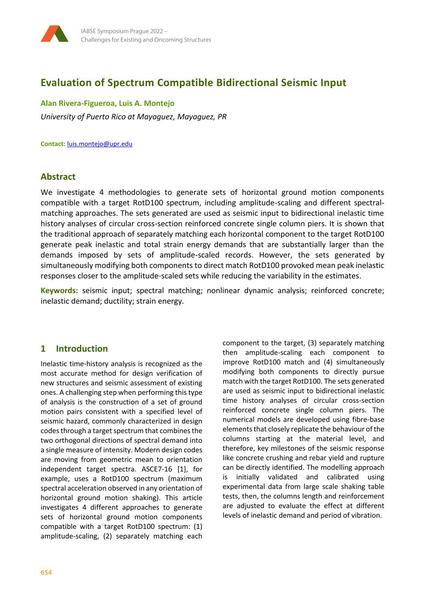Evaluation of Spectrum Compatible Bidirectional Seismic Input

|
|
|||||||||||
Détails bibliographiques
| Auteur(s): |
Alan Rivera-Figueroa
(University of Puerto Rico at Mayaguez, Mayaguez, PR)
Luis A. Montejo (University of Puerto Rico at Mayaguez, Mayaguez, PR) |
||||
|---|---|---|---|---|---|
| Médium: | papier de conférence | ||||
| Langue(s): | anglais | ||||
| Conférence: | IABSE Symposium: Challenges for Existing and Oncoming Structures, Prague, Czech Republic, 25-27 May 2022 | ||||
| Publié dans: | IABSE Symposium Prague 2022 | ||||
|
|||||
| Page(s): | 654-661 | ||||
| Nombre total de pages (du PDF): | 8 | ||||
| DOI: | 10.2749/prague.2022.0654 | ||||
| Abstrait: |
We investigate 4 methodologies to generate sets of horizontal ground motion components compatible with a target RotD100 spectrum, including amplitude-scaling and different spectral- matching approaches. The sets generated are used as seismic input to bidirectional inelastic time history analyses of circular cross-section reinforced concrete single column piers. It is shown that the traditional approach of separately matching each horizontal component to the target RotD100 generate peak inelastic and total strain energy demands that are substantially larger than the demands imposed by sets of amplitude-scaled records. However, the sets generated by simultaneously modifying both components to direct match RotD100 provoked mean peak inelastic responses closer to the amplitude-scaled sets while reducing the variability in the estimates. |
||||
| Copyright: | © 2022 International Association for Bridge and Structural Engineering (IABSE) | ||||
| License: | Cette oeuvre ne peut être utilisée sans la permission de l'auteur ou détenteur des droits. |
||||
